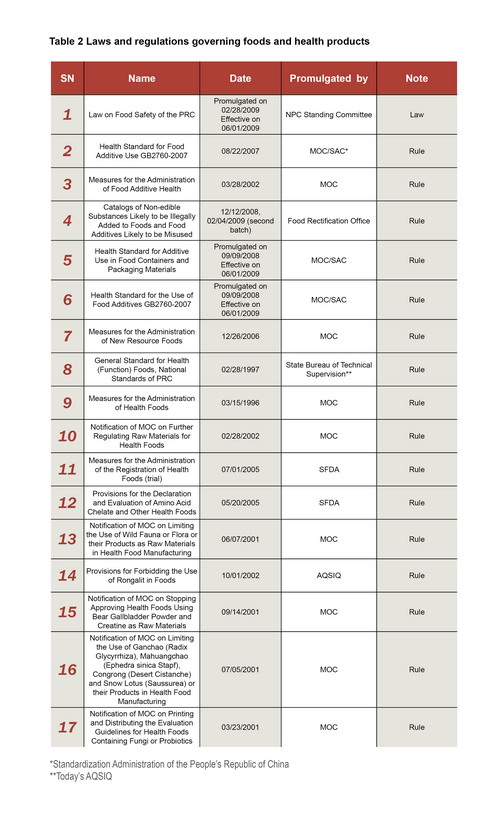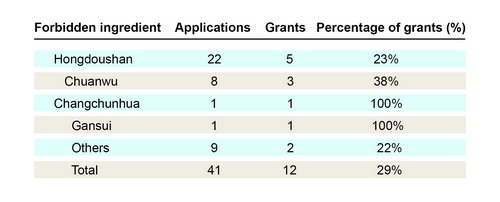Food is the first necessity of the people, and food safety has always been the focus of attention. Recently, a number of food safety scandals were reported in the media, involving the poisonous milk powder in Fuyang, the Sudan Red I in pepper sauces, the excessive iodine in Nestle's milk powder, the malachite green in aquatic products, the clenbuterol in pork, the Sudan Red IV in preserved duck eggs, and the melamine in Sunlove's milk powder. People were frequntly shocked by such food security scandals and their serious consequences. According to incomplete statistics, the poisonous milk powder caused the malnutrition of 229 babies and 12 deaths in Fuyang, and the melamined milk powder of Sunlove led to 294,000 babies suffering from urinary stones nationwide. The severity of the scandals shocked everyone within and beyond China.
Food safety involves many sectors, and any of them can affect the entire chain. The patent examination sector, as one of the watchdogs for food security, may wrongly raise people's awareness of an unhealthy food product should it fail to work properly in granting patents. The relevant market player's publicity of patent grant for its food product might further the industrialization of such food, and hence have more people victimized. If the patent approvers work properly to screen off unhealthy food products from patent grants, they can avoid the bad consequences from granting such patents, and accordingly enhance their credibility and reputation among the people.
 |
| mination to safeguard food and healthy products |
Status Quo
Article 5 of the Patent Law is on food safety which provides, "patent is not granted to inventions or creations that violate laws or social moralities, or impair public interests." The provision regulates three situations of non-granting, namely, any violation of laws; any violation of social moralities; and any impairing of public interests. The Guidelines for Examination, in Article 3.1.1 of Chapter 1, Part II, interprets this further, "the laws herein refer to any enactments formulated and promulgated by the National People's Congress (NPC) or its Standing Committee in accordance with certain legislative procedures, excluding administrative regulations or rules; the social moralities herein mean the ethical or moral views or rules of conduct that are generally deemed justified and acceptable to the general public; the impairing of public interests herein means the harm of any invention or creation, if implemented or exploited to the general public and society or the negative impact on the regular order of the State or society."
Examiners can certainly contribute to the safety of food or health products should they work strictly pursuant to Article 5 of the Patent Law and the Guidelines for Examination. However, we have found in our survey that due to various causes, quite a few patents have been granted to food or health products that are possibly harmful to consumers' health.
The Ministry of Health (MOC) issued on February 28, 2002 the Notice on Further Regulating Raw Materials for Health Products which incorporated a catalog of substances that can be seen either as food or medicines, a catalog of substances that may be used in health products, and a third catalog of substances that are forbidden in health products. The third catalog forbids the use of 59 herbs in health products, including Bajiaolian (Common Dysosmatis Rhizome and Root), Shanlangdang (Henbane Seed), Chuanwu (Aconite Root), Maqianzi (Nux Vomica), mercury, Changchunhua (Catharanthus roseus), Ganshui (Radix Kansui), Sheng Tiannanxing (unprocessed Rhizoma Arisaematis), Sheng Banxia (unprocessed Pinellia Tuber), Guanmutong (caulis Aristolochiae Manshuriensis), Hongdoushan (Chinese Yew), Yangdihuang (Digitalis), Yangjinhua (Hindu Datura Flower), Pishi (Arsenolite) (including White Arsenolite, Red Arsenolite, and Arsenic), Chaowu (Kusnezoff Monkshood Root), Banmao (Mylabirs), and Chanshu (Toad Venom). We surveyed the patent applications, made between 1999 to 2005, of health products which contain forbidden active ingredients under the above catalog. Our study showed that nearly one third of such applications have been granted. See Table 1 below for details.
This situation has roots in several aspects, including, among others, the experience and attitude of examiners, and their knowledge and sensitivity towards food safety-related laws, regulations and rules. Besides, there is still a critical cause, the imperfect provisions and in particular, those on the examination of patent applications for food or health products, in the Patent Law, the Implementation Regulations of the Patent Law, and the Guidelines for Examination.
 |
| Patent examination to safeguard food and healthy products |
Under Article 5 of the Patent Law, examination of food and health products entails knowledge of other laws, regulations and rules governing food and health products, such as those issued by MOC or the General Administration of Quality Supervision, Inspection and Quarantine (AQSIQ). However, except the provision that "the laws herein refer to any enactments formulated and promulgated by the National People's Congress (NPC) or its Standing Committee in accordance with certain legislative procedures, excluding administrative regulations or rules", the Guidelines for Examination gives no other details on the relationship between Article 5 of the Patent Law and other regulations and rules of the MOC or AQSIQ.
China has promulgated on food nearly 800 laws, regulations, rules or normative documents to protect food safety and the health and life of the general public. Particularly, on February 28, 2009, the 7th Session of the 11th NPC Standing Committee passed the Law on Food Safety. These legal documents cover almost the entire chain, from production to sale, of food and health products. Listed below are the leading ones.
As shown, except the Law on Food Safety, others are mostly "rules" under the Patent Law, which were originally made to protect the safety of users and public interests. If all these laws and regulations could be taken into full consideration and made full references, the patent examination process would work as an effective safeguard against unhealthy food or health products. Unfortunately, neither the Guidelines for Examination, nor the examination process, incorporates any consideration thereof.
Conclusion and Suggestions
For the above reasons, we suggest that examiners should focus more on the safety-related aspects of patent applications for food or health products, and the Guidelines for Examination should contain clarifying stipulations on the relationship between patent examination and the laws, regulations and rules governing food and food products. In this way, examiners would give more legally based opinions pursuant to Article 5 of the Patent Law. In case of an application covered by any of the "laws" provided by the Patent Law, an opinion of noncompliance with its Article 5 may be given; in case of an application covered by any other regulations or rules, an opinion of violation of social moralities or impairing of public interests may be given. Moreover, we wish that the following instances could be added to the Guidelines for Examination:
1. In case of any use of expired/spoiled food materials or industrial materials or other non-edible materials in food manufacturing, which violates the Law on Food Safety, examiners may give an opinion of violation of relevant laws and noncompliance with Article 5 of the Patent Law;
2. In case of any use of a commodity name as the name for a raw material in a food patent application, examiners who do not know what compose that raw material, should question the insufficient disclosure of the patent description, and in case such a raw material is found harmful to human body on the basis of the statement of the applicant, may give an opinion of noncompliance with Article 5 of the Patent Law;
3. In case of a patent application of health product which contains ingredients from wild fauna or flora with Level I or II state protection, which violates the Notice of MOC on Limiting the Use of Wild Fauna or Flora or Their Products as Raw Materials in Health Food Manufacturing, and in case the applicant fails to prove any legal source of such ingredients (with a permit for hunting/felling/domesticating/culturing), examiners may give an opinion of imparing of public interests and noncompliance with Article 5 of the Patent Law;
4. In case of a patent application of food or health product which contains poisonous or toxic substances forbidden by the Measures for the Administration of Health Food and in case no poisonous or toxic data or other data proving the safety of such food or health product is supplied in the application, examiners may give an opinion of impairing of public interests and noncompliance with Article 5 of the Patent Law.
A substance is one forbidden in food or health products, unless it is or has been 1) traditionally believed to be a food material; 2) approved as a new resource food; 3) included in the catalog of substances published by the MOC which can be both food and medicines, or treated as a common food material; 4) incorporated into the catalog of food additives of the PRC (as stated in the Health Standard for the Use of Food Additives (GB2760-2007) or food additive-related notices of the MOC), or the catalog of nutrition enhancers (as stated in the Health Standard for the Use of Nutrition Enhancers in Food (GB14880-1994) or food-additive related notices of the MOC); or 5) allowed in food or health products under any other laws, regulations or rules. 5. In case of an application which uses any food additive, examiners should check the type, dose and range of application of the additive for possible violation of food additive-related laws, regulations or rules. In case of any additive forbidden under the Health Standard for the Use of Food Additives, examiners may give an opinion of impairing of public interests and noncompliance with Article 5 of the Patent Law. In case of any additive with limited use, examiners should require the applicant to supply the poisonous or toxic data or any other data proving the safety of the application; otherwise, they may conclude that it impairs public interests. The applicant may re-supply any experimental data on the safety of the application, or reasonably limit the scope of its original descriptions or claims. For non-edible substances likely to be illegally added to food, or food additives likely to be misused, examiners should refer to relevant notices that relevant authorities issue on their websites.
It is certain that the examiners' work can never, nor necessarily be, as strict as that done by AQSIQ on food or health products to be launched onto the market. However, examiners should beware of applications which either apparently violate laws on food safety, or contain forbidden substances under any regulations or rules. They may turn down any of such applications on the ground of either violation of laws, or injuries to public interests. Otherwise, they may decide on their sole discretion, in the case that any safe data are provided or only substances with limited use are added under relevant regulations or rules.
By the Task Group of Patent Examination Cooperation Center, State Intellectual Property Office (SIPO)
(Translated by Ren Qingtao)


